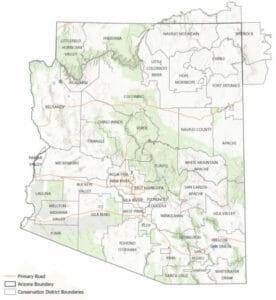By Eric Hemphill, Food Policy and Sustainability Leadership Certificate student
This blog is part of a series from the December Arizona Immersive program of the Food Policy and Sustainability Leadership Graduate Certificate Program. Students virtually toured the state, meeting with farmers, ranchers, entrepreneurs, government staff and non-profit leaders.
This past December, my fellow Food Policy and Sustainability Leadership cohort members and I had the chance to hear from Sharma Torrens, Conservation Education Director for the Arizona Association of Conservation Districts. Torrens took us through the work that AACD does to educate, create partnerships, and implement best practices for conservation work in Arizona.
The AACD is a 501c3 nonprofit organization that is operated by Arizona’s 42 Natural Resource Conservation Districts (NRCD). The AACD serves as the support system for these NRCDs, 32 of which are political subdivisions of the state overseen by the Arizona Bureau of Land Management, and 10 are tribal districts overseen by tribal governance. Each of these 42 NRDCs are governed by 5-7 “supervisors” who are elected or appointed. These farmers, ranchers, and other land owners promote and advance conservation in their district.
“(These supervisors are) volunteering their time… to conserve farms, ranches, our food supply, but also our wildlife habitat, our wildlife migratory corridors, open spaces, water, soil, and more,” said Torrens. The cohort had the chance to meet with many of these supervisors during our immersive experience.
The AACD was created in 1944 to repair and improve Arizona’s soils in reaction to the devastation of the dust bowl over the previous decade. AACD was a continuation of various federal policies around soil conservation, including the Soil Conservation Act of 1935, and model legislation introduced by President Roosevelt in 1937. Today, there are 3,000 NRDCs across the country working on land, soil, water, and wildlife conversation issues.
The AACD interacts with NRCDs in three prominent ways:
Connecting with Landowners
Because the supervisors of each NRCD are farmers/ranchers themselves, it is more effective for them to approach other landowners in the district from the perspective of colleagues in similar fields. This allows them to grow the network of landowners following principles of conservation without outside entities being involved.
Educating the Public
AACD oversees the creation and oversight of education centers in each district. These centers teach about the importance of agriculture and best management practices. Torrens said education and awareness raising about conversation practices are of the utmost importance to the success and expansion of conservation work in the state.
Establishing and Maintaining Partnerships
AACD acts a liaison to various nonprofit, governmental, and educational organizations throughout the state and region. Some of these partnerships result in conservation dollars coming to the state. In 2019, NRCDs secured $42 million for Arizona conservation work. Some of the partners that AACD works with are the Fish and Wildlife Service, the USDA Natural Resource Conservation Service, The US Forestry Service, the Bureau of Land Management, AZ Dept. of Agriculture, AZ Dept. of Environmental Quality, and more.
Torrens’ role within the organization is to spread awareness of the NRCDs throughout the state. “I like to say that NRCDs are Arizona’s best kept secret. The public doesn’t really know they exist, which is a tragedy,” Torrens said.
Conservation is at the heart of what many farmers and ranchers do on a daily basis. So many of the farmers and ranchers the cohort met with this semester considered themselves to be soil farmers first and foremost. They realized that the health of the soil would ultimately affect the health of their produce and livestock, as well as the downstream health of the consumers of their products. Proper conservation practices do not thrive in a vacuum. Much like the livestock and plants that benefit from them, conversation practices proliferate when there is cross-pollination of ideas and best practices; when neighbors share their successes and let others learn from their failures. This is what makes the work of the AACD so vital.
On behalf of my cohort, I’d like to thank the AACD for the work they do each day, and hope that we can do our part to spread the word so that NRCDs cease to be Arizona’s best kept secret.


